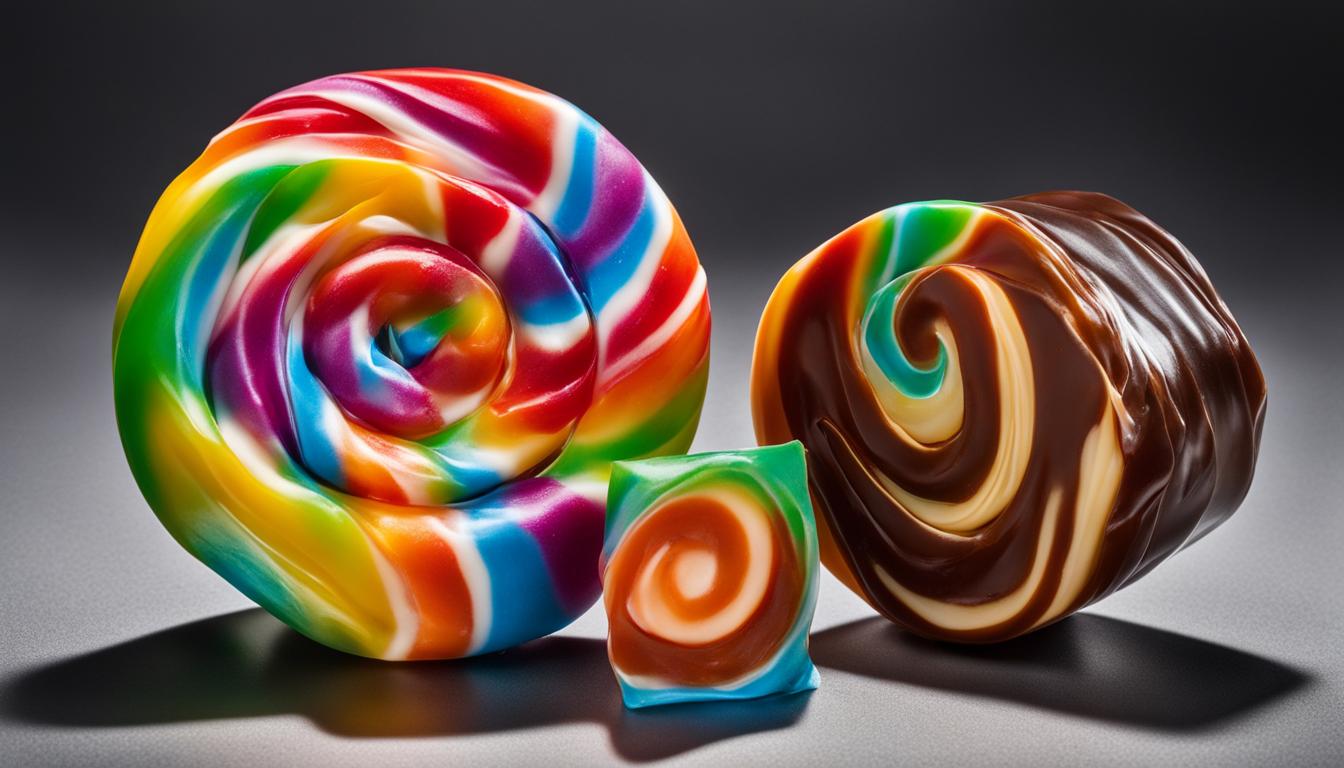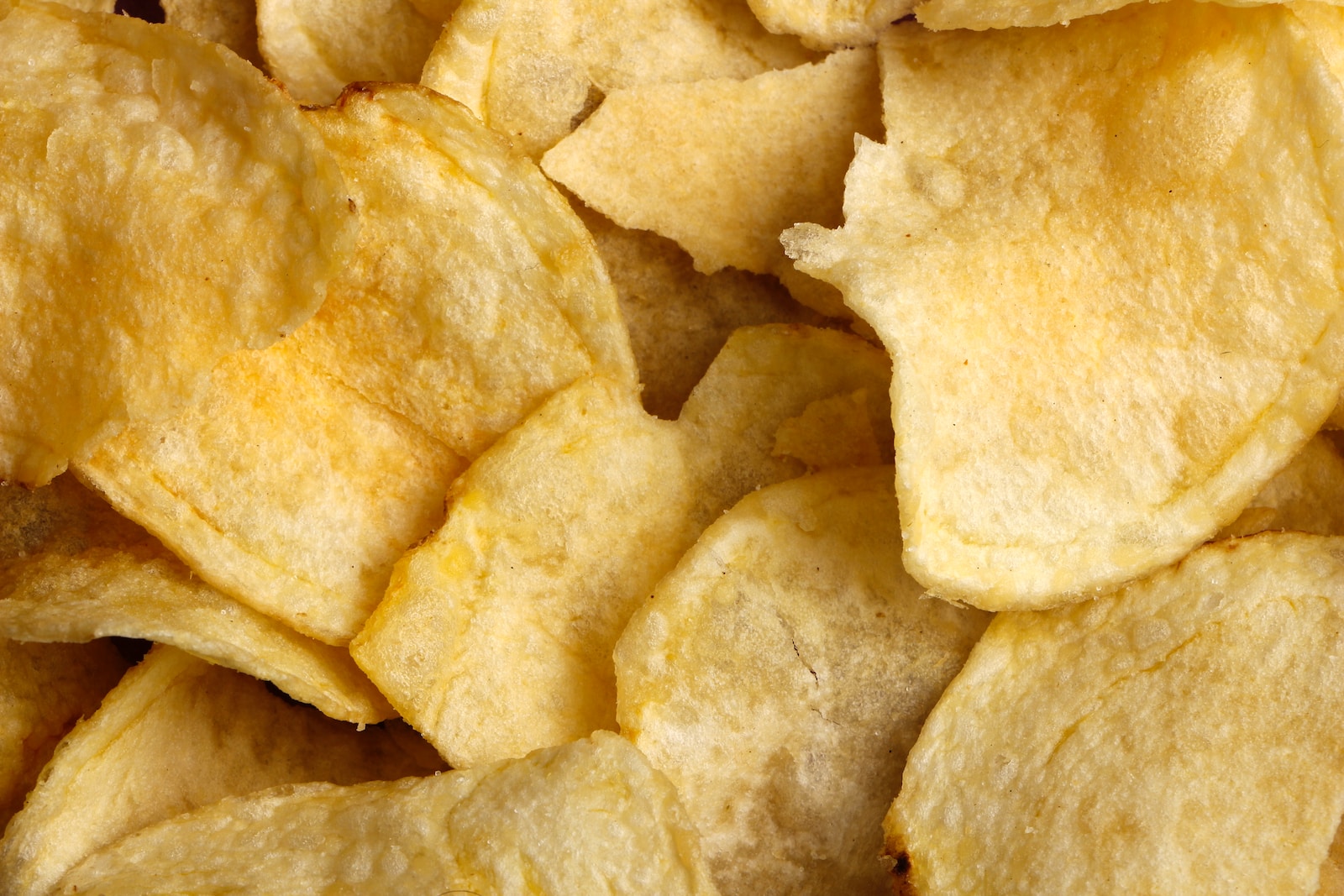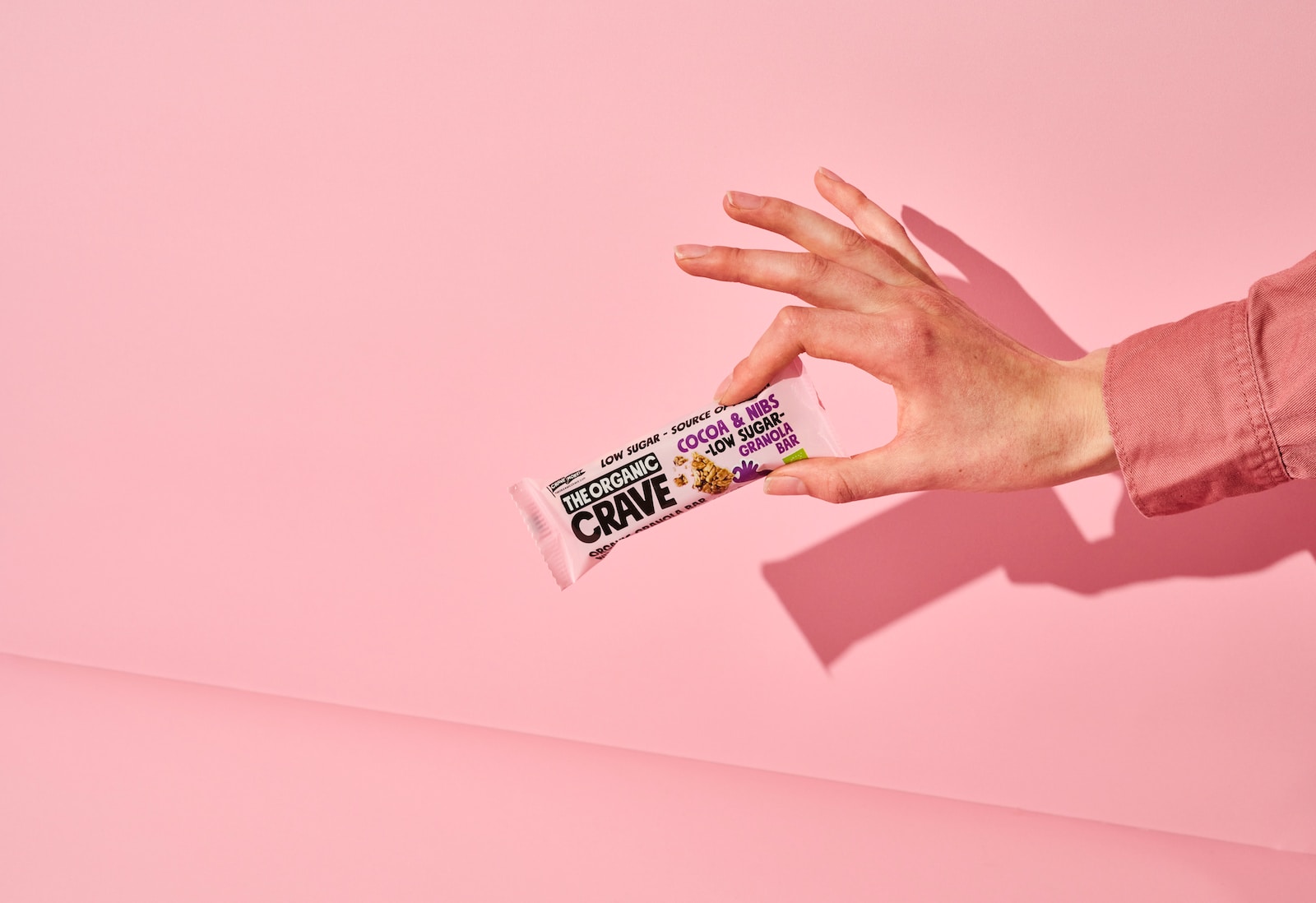Taffy and caramel are popular confections that offer delightful flavors and enjoyable experiences. While they may share some similarities, they also have distinctive differences that set them apart. Understanding these differences can help you choose the perfect sweet treat for your cravings.
Taffy is known for its chewy texture and comes in a variety of fruity or spice flavors. On the other hand, caramel is made from heated sugar and has a creamy, caramelized taste. The naming of these candies also differs, with taffy going by various names like taffy, fruit chews, and chews, depending on the region. Caramel, on the other hand, is commonly referred to as caramel. The ingredients and recipe variations further contribute to the differences between the two candies.
If you’ve ever wondered whether to choose taffy or caramel, this article will explore the contrasts and distinctions between the two, shedding light on their origins, ingredients, cooking processes, textures, and tastes. By the end, you’ll have a deeper understanding of the unique characteristics of taffy and caramel, helping you make the perfect choice for your sweet tooth.
Key Takeaways:
- Taffy and caramel have distinct differences in texture, taste, and naming.
- Taffy is known for its chewy texture and fruity or spice flavors, while caramel has a creamy, caramelized taste.
- The ingredients and recipe variations contribute to the unique characteristics of taffy and caramel.
- Taffy and caramel have a long history with roots dating back to the 18th century.
- Regional variations in names and flavors add to the diversity of taffy and caramel worldwide.
The Origins of Taffy and Caramel
Taffy and caramel have a rich history that dates back to the late 18th century. The initial variations of these candies were made by boiling treacle, molasses, or sugar with butter, resulting in toffee and taffy. Over time, different recipes and regional preferences emerged, leading to the development of distinct candies like butterscotch, soft toffee, and caramels.
In the 19th century, the process of pulling taffy became popular. This technique involved stretching and folding the candy to incorporate air, making it lighter and softer. Taffy pulls, where groups of people would gather to make and enjoy taffy, became popular social events.
Caramel, on the other hand, evolved from the heated sugar process. By cooking sugar to a higher temperature, caramelization occurred, resulting in a rich, golden brown color and a creamy, caramelized taste. The combination of sugar and additional ingredients like butter, milk, and vanilla created the distinct flavor profile of caramel as we know it today.
| Taffy | Caramel |
|---|---|
| Roots in toffee and treacle | Evolved from heated sugar |
| Pulling process for lighter, softer texture | Cooked to higher temperatures for caramelization |
| Fruit or spice flavors | Creamy, caramelized taste |
| Regional variations like butterscotch | Used in various desserts and sauces |
The Ingredients of Taffy and Caramel
When it comes to taffy and caramel, the ingredients play a significant role in shaping their unique flavors and textures. While both candies share sugar as a primary ingredient, the additional components differentiate them.
In traditional taffy recipes, you will find a combination of sugar, corn syrup, and flavorings such as fruit extracts or spices. Some taffy recipes also incorporate milk or gelling agents for added creaminess or texture. The variations in flavorings contribute to the wide range of fruity and spicy options available in taffy.
On the other hand, caramel is primarily made from white granulated sugar. The caramelization process occurs when the sugar is cooked at high temperatures, resulting in the distinct caramel taste. Caramel can be made with or without additional ingredients like butter, milk, and vanilla, depending on the desired richness and flavor profile. The simplicity of caramel’s ingredient list allows its rich, caramelized taste to take center stage.
Taffy Recipe
To give you a better understanding of the ingredients in taffy, here is a basic taffy recipe:
| Ingredients | Amount |
|---|---|
| Sugar | 2 cups |
| Corn syrup | 1 cup |
| Flavorings (fruit extracts or spices) | As desired |
| Milk or gelling agents (optional) | As desired |
Caramel Recipe
For caramel enthusiasts, here is a simple caramel recipe:
| Ingredients | Amount |
|---|---|
| White granulated sugar | 1 cup |
| Butter | 1/2 cup |
| Milk or cream | 1/2 cup |
| Vanilla extract (optional) | 1 teaspoon |
The choice of ingredients and their proportions can vary in different recipes and regional preferences, resulting in a wide array of taffy and caramel variations. These variations contribute to the diverse flavors and textures found in confectioneries around the world.
The Cooking Process of Taffy and Caramel
The cooking process of taffy and caramel involves precise temperature stages to achieve the desired texture and consistency. Taffy-making begins by heating sugar, corn syrup, and other ingredients in a saucepan. The mixture is cooked to the soft-crack stage, where the sugar concentration reaches about 95%. This stage is crucial for taffy’s chewy texture. Once the desired temperature is reached, the hot syrup is poured onto a greased surface and allowed to cool briefly. Then the taffy is pulled and folded repeatedly to incorporate air and create a light, pliable consistency.
Caramel-making, on the other hand, requires a higher cooking temperature compared to taffy. The process begins by heating sugar in a heavy-bottomed pan until it melts and caramelizes. The sugar is cooked until it reaches around 340 degrees Fahrenheit, resulting in a rich golden brown color and a creamy, caramelized flavor. Additional ingredients like butter, milk, and vanilla may be added to enhance the taste and texture of the caramel. Once cooked, the caramel can be poured into molds or used as a topping or filling in various desserts.
The candy temperature stages play a crucial role in determining the final texture and consistency of both taffy and caramel. While taffy is cooked to the soft-crack stage, caramel requires a higher temperature for caramelization. Each candy-making process requires precision and careful attention to achieve the desired results.
| Candy | Cooking Process | Temperature Stage |
|---|---|---|
| Taffy | Heat sugar, corn syrup, and other ingredients. Pour onto a greased surface, cool briefly, and pull repeatedly. | Soft-crack stage (around 95% sugar concentration) |
| Caramel | Heat sugar until it melts and caramelizes. Add additional ingredients like butter, milk, and vanilla. Pour or use as a topping/filling. | Around 340 degrees Fahrenheit |
Texture and Taste Differences of Taffy and Caramel
When it comes to texture, taffy and caramel offer distinct experiences. Taffy is known for its chewy consistency, which is achieved through the pulling process. It has a softer and pliable texture compared to caramel. The act of pulling taffy not only creates its signature chewiness but also incorporates air into the candy, resulting in a lighter and more enjoyable mouthfeel. On the other hand, caramel has a creamy and smooth texture. It melts in your mouth and offers a rich and luscious sensation. The creaminess of caramel is a result of the caramelization process, where sugar is heated to a high temperature, creating a deep golden color and a thick, indulgent texture.
When it comes to taste, taffy and caramel are equally distinct. Taffy delights with its wide range of fruity or spice flavors. From classic fruit flavors like strawberry and cherry to unique combinations like watermelon chili, taffy offers a burst of sweetness and a hint of tanginess. The added flavorings in taffy contribute to its playful and vibrant taste. On the other hand, caramel is all about its intense caramelized flavor. Made from heated sugar, caramel develops a rich and buttery taste that is often described as “toffee-like.” The bittersweet notes of caramel make it a beloved treat on its own or as an ingredient in various desserts.
In summary, taffy and caramel differ both in terms of texture and taste. Taffy has a chewy and pliable texture, while caramel offers a creamy and smooth mouthfeel. Taffy delights with its fruity or spice flavors, while caramel captivates with its intense caramelized taste. Whether your preference is for the chewy nature of taffy or the creamy goodness of caramel, both candies provide unique and enjoyable sensory experiences.
Regional Variations and Names of Taffy and Caramel
Taffy and caramel have regional variations, not only in their flavors but also in their names. In Canada and the USA, taffy is commonly referred to as taffy or fruit chews. In the UK and Ireland, it is known as chews or fruit chews. In Australia and New Zealand, the popular term is toffee. Other descriptive terms like “soft candy” or “chewy sweets” are also used to describe these confections. Brand names like “Starburst” or “Hi-Chew” are often used as well. These regional preferences contribute to the diverse range of names for taffy and caramel worldwide.
Similarly, caramel also has different names in various regions. While caramel is the commonly used term, there may be regional variations in the naming of specific caramel-based products. For example, in some countries, caramel sauces are known as dulce de leche or caramel dulce. These names reflect cultural and linguistic differences and add to the international variations of taffy and caramel.
The image below illustrates some of the regional variations in names for taffy and caramel:
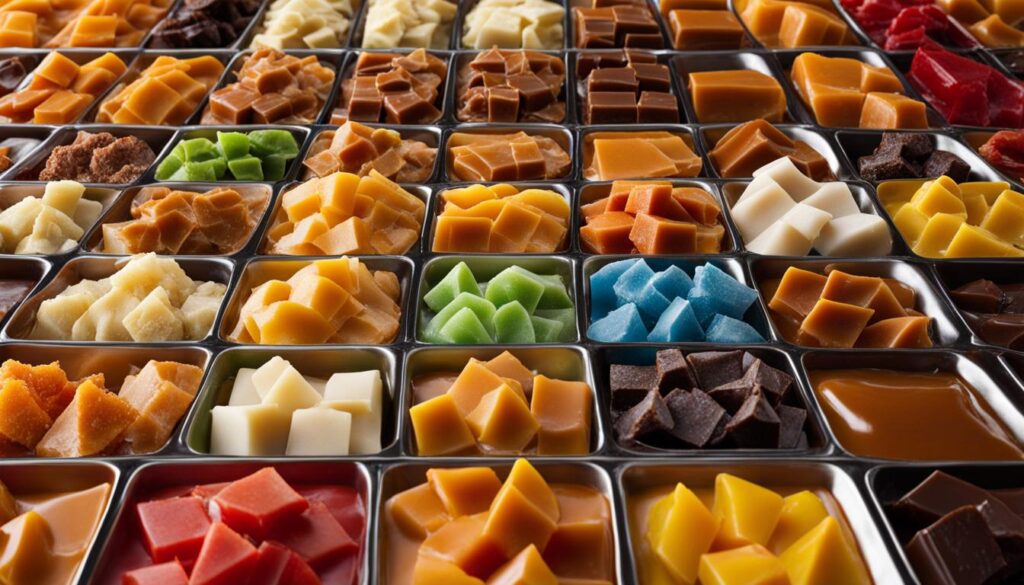
As the table shows, taffy is known by different names in different regions, highlighting the diverse cultural influences on candy naming. Similarly, caramel has various names worldwide, reflecting the global popularity and versatility of this confectionary treat. Whether you call it taffy, chews, or toffee, or prefer the term caramel, the delicious taste of these candies remains a universal delight.
Salt Water Taffy and its Unique Naming
Salt water taffy is a beloved confection that has become synonymous with taffy in many regions, especially in the United States. Despite its name, salt water taffy doesn’t actually contain salt water. The term “salt water” originated from its association with the sea and the coastal boardwalks of Atlantic City, New Jersey, where the candy gained popularity. The history of salt water taffy is intertwined with the marketing efforts and allure of Atlantic City as a beach resort destination.
The unique naming of salt water taffy adds to its allure and mystique. The name itself sparks curiosity and evokes memories of vacations by the seaside. Despite its coastal origins, salt water taffy is enjoyed by people worldwide, providing a taste of summer and the nostalgia of carefree days spent at the beach.
| Popular Misconception | Reality |
|---|---|
| Salt water taffy contains salt water. | Salt water taffy does not contain salt water. It is a sweet, chewy candy made with sugar, corn syrup, and flavorings. |
| Salt water taffy can only be found in coastal areas. | Salt water taffy is enjoyed globally and can be found in candy stores and online retailers. |
| The name “salt water taffy” was derived from the ingredients. | The name “salt water taffy” was created as a marketing ploy to attract tourists to Atlantic City. |
Today, salt water taffy continues to be a popular treat for beachgoers, candy enthusiasts, and anyone seeking a taste of nostalgia. Its chewy texture, wide range of flavors, and unique naming make it a delightful and enjoyable confection.
Butterscotch as a Variation of Taffy and Caramel
Butterscotch is a delicious variation of both taffy and caramel that offers a unique taste experience. Made by combining butter and brown sugar, butterscotch has a rich, sweet, and buttery flavor that sets it apart from traditional taffy and caramel. Its distinct taste adds depth and complexity to desserts and confections, making it a popular choice among those with a sweet tooth.
To make butterscotch, a mixture of brown sugar and butter is heated until it reaches the desired consistency and flavor. Depending on the recipe, additional ingredients like heavy cream or vanilla extract may be incorporated to enhance the taste. The cooking process and ingredients used contribute to butterscotch’s smooth and creamy texture, which is different from the chewy consistency of taffy and the softer, caramelized texture of traditional caramel.
While the exact origin of the term “butterscotch” is unclear, it has been used to describe the flavor combination of butter and brown sugar since the 19th century. Today, butterscotch is enjoyed in various forms, including candies, sauces, and desserts. Its versatility and delightful taste make it a favorite among dessert enthusiasts and those seeking a sweet treat with a twist.
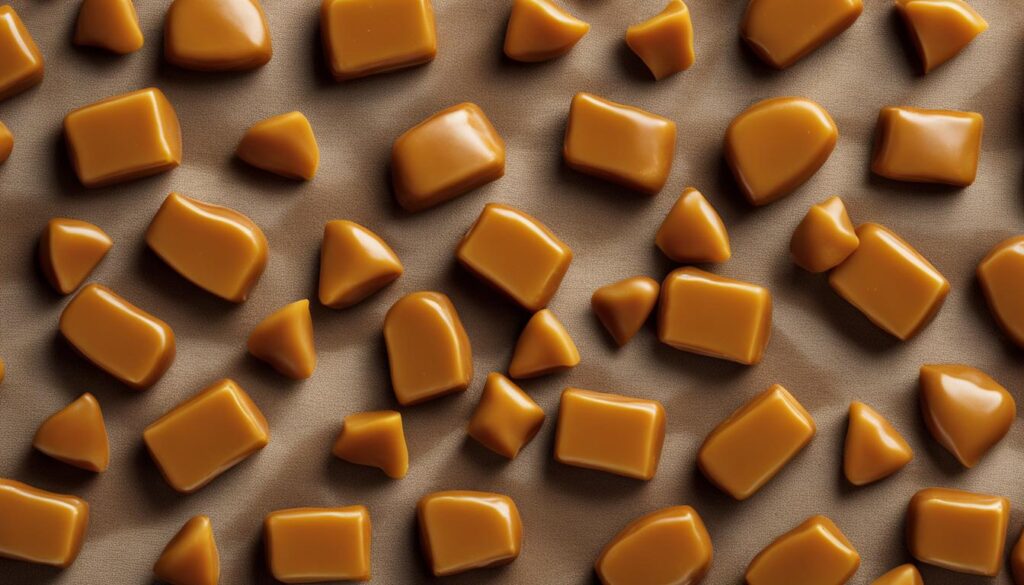
Table: Comparison of Butterscotch, Taffy, and Caramel
| Candy | Taste | Texture |
|---|---|---|
| Butterscotch | Rich, sweet, and buttery | Smooth and creamy |
| Taffy | Fruity or spicy | Chewy and pliable |
| Caramel | Creamy and caramelized | Soft and caramelized |
As seen in the table above, butterscotch stands out with its unique taste and texture compared to taffy and caramel. While taffy offers a chewy experience with fruity or spice flavors, caramel provides a creamy and caramelized taste. Butterscotch, on the other hand, combines the richness of butter and brown sugar to create a distinct and indulgent flavor profile.
Whether it’s enjoyed in candies, sauces, or desserts, butterscotch is a delightful variation of taffy and caramel that adds a touch of sweetness and sophistication to any culinary creation.
Popular Uses of Taffy and Caramel
Taffy and caramel are versatile candies that have found their way into various culinary traditions and desserts. They offer a wide range of uses and can be enjoyed in different ways. Here are some popular uses of taffy and caramel:
Taffy in Candy Stores
Taffy is commonly found in candy stores, especially those located in tourist destinations and boardwalks. Its vibrant colors and irresistible chewy texture make it a favorite treat among both children and adults. Candy stores often offer a wide assortment of taffy flavors, allowing customers to mix and match their own selection. Taffy also makes for a great gift or souvenir, as it captures the essence of classic candy-making traditions.
Caramel in Desserts
Caramel is a popular ingredient in a variety of desserts. From caramel sauce drizzled over ice cream to caramel-filled chocolates and caramel apples, the possibilities are endless. Caramel adds a rich and sweet flavor to baked goods like cakes, cookies, and brownies. It can be used as a filling, a topping, or a decorative element. Caramel also plays a prominent role in traditional desserts like flan and crème caramel, where its creamy consistency and caramelized taste shine.
| Taffy | Caramel |
|---|---|
| Enjoyed as a standalone candy | Used in a wide range of desserts |
| Popular in candy stores and boardwalks | Commonly used in caramel apples and sauces |
| Comes in various flavors | Offers a creamy and caramelized taste |
Whether you’re indulging in a piece of taffy or savoring a caramel-filled dessert, these candies bring joy and sweetness to any occasion. The popularity of taffy and caramel continues to grow, and their uses are only limited by one’s imagination. So next time you reach for a candy treat or whip up a delectable dessert, remember the delightful flavors that taffy and caramel have to offer.
Conclusion
Taffy and caramel may share similarities, but they also have distinctive differences in their ingredients, cooking processes, textures, and tastes. The variations in names and regional preferences further contribute to the uniqueness of these candies.
Whether you prefer the chewy and fruity nature of taffy or the creamy and caramelized goodness of caramel, both candies offer delightful flavors and enjoyable experiences.
FAQ
How does taffy differ from caramel?
Taffy and caramel have distinct differences in terms of texture and taste. Taffy is known for its chewy consistency and fruity or spice flavors, while caramel is made from heated sugar and has a creamy, caramelized taste.
What are the origins of taffy and caramel?
Taffy and caramel have a long history dating back to the late 18th century. Taffy was originally made by boiling treacle, molasses, or sugar with butter, while caramel was developed from variations of sugar and butter cooking techniques.
What are the ingredients used in taffy and caramel?
Taffy recipes typically include sugar, corn syrup, flavorings, and sometimes milk or gelling agents. Caramel is primarily made from white granulated sugar and can be cooked with or without added ingredients like butter, milk, and vanilla.
What is the cooking process for taffy and caramel?
Taffy is cooked to a soft-crack stage and then pulled to incorporate air, creating a chewy texture. Caramel is cooked to a higher temperature, leading to caramelization and the development of a rich, golden brown color.
How do the textures and tastes of taffy and caramel differ?
Taffy has a chewy and pliable texture, while caramel is creamier. Taffy can have fruity or spice flavors, while caramel has a rich, caramelized taste.
Are there regional variations and names for taffy and caramel?
Yes, taffy goes by various names like taffy, fruit chews, and chews in different regions. Caramel is the commonly used term. Regional preferences contribute to the diversity of these candies.
What is salt water taffy?
Salt water taffy is a specific style of taffy that originated in Atlantic City, New Jersey. It earned its name from its association with the sea, although it doesn’t actually contain salt water.
How does butterscotch relate to taffy and caramel?
Butterscotch is a variation of both taffy and caramel, characterized by the combination of butter and brown sugar. It can be made into a soft-crack candy or incorporated into a caramel sauce.
What are the popular uses of taffy and caramel?
Taffy is commonly enjoyed as a standalone candy and is popular in candy stores and boardwalks. Caramel is used in a wide range of desserts, such as caramel apples, caramel sauces, and candies.
What are the differences between taffy and caramel?
Taffy and caramel share similarities but also have distinctive differences. The ingredients, cooking processes, textures, and tastes vary between the two candies. Regional preferences and naming conventions further contribute to their uniqueness.
 Skip to main content
Skip to main content